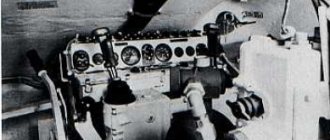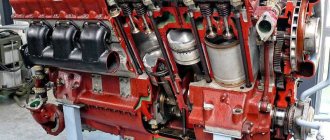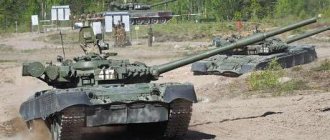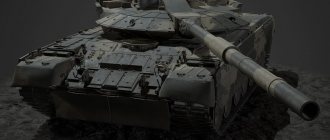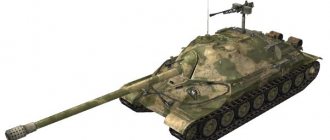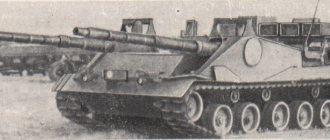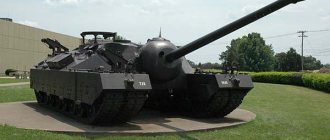In 1973, new tanks entered service with the Soviet Army, fully meeting the requirements of modern warfare and the army doctrines of the USSR.
Photo of the T-72 "Ural" tank
Although the vehicle was a compromise, it had high combat effectiveness and, most importantly, manufacturability. This factor made it possible to produce the tank in mass quantities in the event of a “hot” war. The vehicle received the working name T-72 “Ural” or Object - 172M.
T-72 "Ural" - one of the first photographs
The T72 tank can be called a long-liver. Full production of the model started in 1973 and ended in 1992. Despite the fact that it is no longer produced, the combat vehicle has not been removed from service in the Russian Federation.
See also the article Tank T-80 and its modifications
Modifications of already released samples are being carried out.
The latest versions of the T-72B3 are almost as good as the T90 in terms of tactical and technical parameters. Over the entire period of operation, approximately 30,000 units were produced, not counting those produced by other countries: Poland, Yugoslavia, India, etc.
History of the creation of the T-72 tank
After the introduction of the T-64A into mass production, key shortcomings of this vehicle were immediately revealed. First of all, problems with the engine and chassis. There were also complaints about the automatic loader. For example, in order for the driver to move to the fighting compartment, he needed to turn the turret 90 degrees relative to the tank’s movement vector and remove part of the ammunition rack.
But the main problem was the high cost and difficulty in setting up production at other factories in the country. This was the price of innovation applied by Kharkov engineers.
The first Soviet MBT - T-64A
For the above reasons, the development of a new tank began, similar in combat effectiveness, but with a lower price and high manufacturability.
| Year | Event |
| 1967 | Issuance of a decree on the start of development of the T-72 tank |
| 1968 — 1969 | Field tests of two T-64s. One with a B-45 with ejection, the second with the same engine, but with a ventilated cooling system and a different chassis (the second option was presented by the Uralvagonzavod Design Bureau) |
| 1969 | The Ural version of the T-64 has successfully passed tests. The number of charges in the automatic loader was reduced to 22. A V-46 power plant (780 l/s) was installed. The new vehicle was given the name “Object 172M” |
| 1973 | Start of serial production of T-72 “Ural” |
| 1974 | Receipt of Object 172 to the army units of the Soviet Union |
| 1992 | End of production |
| 2016 | Beginning of modernization of earlier vehicles to the T-72B3 version of the 2016 model |
If we talk about the combat effectiveness of the tank, then the vehicle performed well in numerous conflicts of the 20th century across most of the Earth. Speaking about the experience of operation in the USSR and Russia, these are: Afghanistan, Chechnya, South Ossetia. It was these vehicles that formed the basis of the “tank fist”, which, according to the Soviet command, was supposed to reach Western Europe, regardless of losses.
T-72 with dynamic protection
Tank modifications
Second modernization of the T-72B
Over more than forty years of operation, many modifications were made for the T-72. Even at the development stage in the late 60s, there were several projects whose developments were involved in further improving the tank.
Among the Soviet and Russian modifications of the T-72 tank are:
- T-72 "Ural" - the basic version of the tank;
- T-72K - command tank with additional navigation, improved R-130M radio station and autonomous power supply;
- T-72A - modernization in 1979, received improved armor, additional surveillance and guidance devices, smoke grenades, B-46-6 engine with increased chassis dynamics;
- T-72AK - command version of the modernized tank;
- T-72M and T-72M1 - export model of the T-72A and its modernization;
- T-72AV - a modernized tank with mounted Kontakt dynamic protection;
- T-72B - modernization of the tank in 1985, received the Svir guided weapon system, Kontakt dynamic protection, V-84 engine, new 2A46M gun, armor increased to 570 mm;
- T-72B1 - command version of the T-72B;
- T-72S - an export lightweight modification, after some deliveries were disrupted, it entered service with the Russian Army;
- The T-72B2 “Slingshot” received an improved 2A46M5 gun with increased firing accuracy, and electromagnetic protection against mines appeared;
- The T-72B3 has several models (2011, 2014 and 2016) with modern equipment, weapons and armor.
Taking into account export supplies, modernizations and modifications of the T-72 appeared in other countries. The tank was manufactured under license in Yugoslavia (M-84), Poland (RT-91), Czechoslovakia and India; on its basis, these countries developed their own models. After the collapse of the USSR, Ukraine, Belarus, Kazakhstan, and Azerbaijan appeared in their own versions. Israel, Romania, and Iraq also had their own modifications of the T-72.
Foreign production
The T-72 is in service in 40 countries around the world, but only a small part of them are engaged in production under license. For the most part, the exploiting countries are the former Soviet republics, the countries of the Middle East, India, Finland, and Poland. Currently, modifications of the Ural are actively used in Syria on both sides.
The T-72 is in service in 40 countries around the world.
Some optimistic publications claim that the export seventy-twos adequately fought the American Abrams. In reality this is not the case. More technically advanced A1M1s destroyed T-72M1s in batches during the Iraq War.
T-72 was produced not only in the USSR
An interesting fact is the possibility of supplying T-72 to North Korea. According to some sources, local designers, through reverse engineering, were able to copy the tank and set up production. At the same time, the first models were equipped with a 115 mm gun and had 4 crew members, which indicates the absence of an AZ. Later versions began to be equipped with it.
See also the article Russian tank T-14 “Armata” and its description
Producing countries:
| India | 1988 – 2005 |
| Poland | 1979 – 1995 |
| Czechoslovakia | 1971 – 1991 |
| Yugoslavia | 1981 – 1990 |
| Iraq | 1988 — 1989 |
Use in combat conditions
Since its adoption, the T-72 and its modifications have been actively used by its operators in all conflicts in the Middle East, Europe, Africa, the Caucasus and Ukraine. With the use of this tank, the following operations are distinguished:
- Iran-Iraq War 1980-88;
- Lebanon War 1982;
- Chadian-Libyan conflict 1987-90;
- Gulf War 1990-91;
- August 1991 coup in the USSR;
- Nagorno-Karabakh conflict 1991-94;
- Bosnian War 1992-95;
- Civil war in Tajikistan 1992-95;
- Chechen wars 1994-96 and 1999-2002;
- Kosovo conflict 1998-99;
- Iraq War 2003;
- operation in Beslan 2004;
- War in South Ossetia 2008;
- Civil war in Libya 2011;
- Border conflict in Sudan 2012
T-72s were also used in Indian peacekeeping missions in Sri Lanka and Somalia. These tanks have been used to date in Syria since 2011, as well as in the conflict in eastern Ukraine since 2014.
Design Features
The T-72 tank is made according to the classic Soviet design with the division of the internal armor space into three parts: the control compartment, the fighting compartment and the MTO (motor-transmission compartment). In the front of the vehicle, behind the main armor, there is a driver's seat and traffic controls.
There are 3 crew members in total. The rest are located in the fighting compartment in the center of the tank. This is the commander and gunner. The power plant and transmission elements are installed in the stern.
T-72 side view
There is also an automatic gun loader for 22 rounds. Unlike the T-64, the T-72 tank is not attached to the turret and there is no need to disassemble part of the ammunition rack to get to the control compartment. After the shot, the internal space is cleaned of powder gases by exhausting it to the outside with a fan.
The turret has a hatch for dumping a tray of spent cartridges, which burns out during the salvo. If the AZ carousel runs out of shells, the gun can be charged manually. This function is performed by the commander.
The average rate of fire is 6-8 rounds per minute.
The tower is driven by hydraulic and manual drive. In the upper left part is the main hatch for loading and unloading the crew. A flashlight is installed on the front. Inside the turret there are surveillance devices, including sights, viewing devices, and night vision devices. Thermal imagers have begun to appear in recent modifications. For stabilization, a two-plane stabilizer is used.
Object 172M1 Side and top view
Armor protection of the T-72 tank
The armored hull of the tank is welded, assembled from sheets of durable rolled homogeneous steel, as well as sheets with a combined layer of fiberglass. Armor - differentiated. This means that it is unevenly distributed on the sides. This makes the design easier. This concept can be seen on all modern tanks.
Booking scheme
The thickest armor is at the front. It consists of two armor plates converging like a wedge at different angles:
- the angle of inclination of the upper frontal part is 68 degrees, the lower - 60;
- The VLD in cross-section resembles a “sandwich” of 3 layers: the top one is 80 mm steel, the middle one is 105 mm fiberglass, the inner one is 20 mm armor;
- NLD - 85 mm simple armor steel without additional layers.
This armor arrangement allows it to withstand hits from sub-caliber shells with an armor penetration of 450 mm and cumulative shells with an armor penetration of 600 mm.
All other armoring is done entirely using homogeneous sheets. Along the sides:
- 80 mm sheets cover the crew and ammunition rack;
- 70 mm armor covers the MTO;
- a double part covers the rear of the tank.
In order to increase security, 3-mm aluminum screens are hung on the sides of the tank. The main task is to cover important parts from cumulative grenades and shells. The screens have two positions: combat and traveling. In the first case, they open forward at an angle of 60 degrees.
Subsequently, dynamic protection began to be attached to the tank. In various modifications it was: Contact-1, Contact-5 and Relic. It was planned to install active protection complexes (KAZ) "Arena". But such a module will appear only on versions B3 in 2022. There was also a practice of welding additional armor sheets up to 30 mm thick.
Front view
The first versions of the T-72 had a significant drawback - the armor of the cast turret was monolithic. In the T-72A this was corrected and a combined layer appeared in the frontal projection. In the T-72B model, the filler was replaced with reflective elements. The turret was additionally equipped with modules for firing smoke grenades.
Advantages and disadvantages
Operating countries of the T-72 and its modifications, former operators are marked in red.
The main advantage of the T-72 is its versatility. The optimal combination of key indicators made the tank one of the most widely produced, especially among the early models. To this day, modernized versions remain in demand.
Another advantage of the tank is that it is a good upgrade resource. The initial design turned out to be not only successful for practical use, but also made it possible to improve the machine, developing numerous modifications.
However, it was not without its drawbacks. One of the first to eliminate monolithic turret armor, replacing it with a combination one. However, problems remained with the layout and close quarters of the crew.
This aspect is complicated by the presence of fuel tanks and ammunition next to the crew. If a car explodes, it is quite difficult to leave it, especially if there is a fire or injury. This also negatively affected the crew; tanks that were still suitable for combat and repair were often abandoned due to panic.
They also pay attention to the tank’s mediocre suitability in urban combat. There are several vulnerabilities in the design and armor; the use of high-precision anti-tank weapons can quickly disable the T-72.
Attention is also drawn to the high cost of modernization, especially in relation to radio-electronic equipment. This aspect calls into question the further use of the T-72 and its modifications for modern methods of combat. Despite this, the use of such vehicles in mass battles remains relevant.
Armament
In the front of the turret there is a gun with the index 2A26M.
- gun caliber - 125 mm;
- length is 50.5 calibers.
The gun is smooth-bore; it is possible to launch guided missiles using the Svir system. The main set of shells used consists of sub-caliber, high-explosive fragmentation and cumulative shells. The gun has separate-case loading, carried out by the AZ or the tank commander.
T-72 automatic loader diagram
The additional weapon is a 7.62 mm PKTM machine gun, coaxial with the cannon. To suppress manpower, light armored vehicles and low-flying targets, a 12.7-mm Utes machine gun mounted on the turret roof is used. In order to reduce the cost of production, a remote control system is not provided.
To fire, the commander has to lean out of the hatch on the turret, which is a disadvantage.
Main goals and objectives
The T-72 is a medium tank. The main emphasis of such vehicles was on speed and good striking power, allowing them to develop an offensive and overcome weakly fortified lines. In modern classification, such vehicles are defined as main battle tanks.
The key feature of this type of equipment is versatility and multitasking. The combination of mobility, combat power and significant protection expands the tank's potential use. It can be used in large-scale offensives and local conflicts, supporting small detachments or breaking through fortified defense lines.
There are no separate combat missions or specializations for such vehicles. They are determined by the front-line situation and practical necessity. It is this aspect that is considered the key advantage of the main battle tank.
Mobility
The tank's cross-country ability was at a high level. Over rough terrain, the maximum speed of the T-72 is 30 km/h. The chassis resembles that of the T-62. It has 3 support rollers and 6 support rollers on each side. The drive and guide wheels are located at the rear. The suspension itself is individual, torsion bar.
An interesting addition is the presence of a device for self-digging.
Using this device, the crew is able to dig a trench in 30 minutes. The device was placed on an NLD, which provided greater security.
Chassis of the Ural
Initially, the T-72 was equipped with a V-46 engine with a power of 780 l/s. The engine was a direct development of the famous B-2, first used on the T-34. It has 12 cylinders and a V-shape.
Capable of running on diesel, kerosene and gasoline.
In later modifications, more advanced power units were introduced into the T-72 tank. The fuel system consists of 4 internal tanks and 5 external ones. One internal tank is located in the aft part of the fighting compartment, the rest are located around the driver. Volume - 705 l. This arrangement is a signature feature of the Soviet tank school.
External tanks are integrated into the right fender. Volume - 495 liters. In addition, during long forced marches, additional tanks are installed on the tank. They are hung at the stern. Depending on the size, this is 400-500 liters.
The transmission consists of:
- a multiplier through which torque is transmitted to the gearbox;
- pairs of gearboxes, each connected to clutches on the sides of the tank, which makes it possible to control the vehicle;
- planetary gears.
Tactical and technical characteristics of the T-72 tank (TTX)
| Weight, t | 46 |
| Combat composition of the tank | 3 persons |
| Length x Width x Height x Ground clearance, m | 9.5 x 3.4 x 2.1 x 0.42 |
| Hull armor: forehead x side, mm | 205 x 70 - 80 |
| Tower forehead, mm | Protects 410–1200 equivalent |
| Smoothbore gun 125 mm caliber | 2A46 |
| Firing range, km | 9,4 |
| Additional weapons | 7.62 mm PKTM, 12.7 mm NSVT |
| V-shaped 12-cylinder engine B-46 | 780 l/s |
| Maximum speed | 35–50 km/h |
| Average range, km | 600 |
| Volume of fuel containers, l | 1600 |
